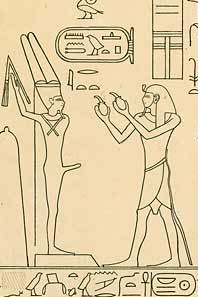|
Mentuhotep IV
Nebtawyre Mentuhotep IV was the last king of the 11th Dynasty in the Middle Kingdom. He seems to fit into a 7-year period in the Turin Canon for which there is no recorded king. FamilyKing's Mother ImiIn Wadi Hammamat, a rock inscription (Hammamat M 191) with the royal name of Mentuhotep IV also mentions King's Mother Imi.[5] This monument only focus on the title King's Mother, presumably the mother of Mentuhotep IV. It does not include other titles like King's Wife, King's Sister or King's Daughter. Some have speculated that she was a concubine in the royal harem. Mentuhotep III or Mentuhotep IIIt is not certain who the father of Mentuhotep IV was. Most scholars suggest that he was the son and successor of Mentuhotep III. However, it is also possible that he was a son of Mentuhotep II, thus a brother or half-brother of Mentuhotep III. The fact that he has been omitted from several king lists indicate that there was a crisis in the order of succession. He also represents the last king of the eleventh dynasty, and his reign is poorly documented indicating turmoil. Rock inscriptionsHe is known from several inscriptions at several locations, despite his reign being omitted from the Abydos king list. The inscriptions show the organization and makeup of a large expedition during his reign. Wadi el-HudiAlso, he is attested by the inscriptions at Wadi el-Hudi.[6]
Ain SukhnaAt the Red Sea port of Ain Sukhna expeditions went to places like the Wadi Maghareh in the Sinai. Products like turquoise and copper were transported to Memphis some 120 km across the sand tracks of the Eastern Desert. Or perhaps transported along the Red Sea coast further south to the port of Mersa Gawasis. Inscriptions dated to Mentuhotep IV have been found.[7]
Wadi Hammamat (Eastern Desert)He is known from a few inscriptions in Wadi Hammamat that record expeditions to the Red Sea coast and to quarry stone for the royal monuments. One of these inscriptions confirms the name of his mother to be King's Mother Imi. The leader of an expedition to Wadi Hammamat, during the second year of Mentuhotep IV's reign, was his vizier, Amenemhat, who is assumed to be the future king Amenemhat I, the first king of the 12th Dynasty, and Mentuhotep's immediate successor.
Other attestationsA fragment of a slate bowl found at Lisht North was regarded for a long time to be inscribed on the outside with the official titulary of Mentuhotep IV, and on the inside with that of King Amenemhat I, his successor. Since the two inscriptions are incised in a different style of writing, according to Dorothea Arnold, this indicates that Amenemhat had his name added to an older vessel that already bore the name of Mentuhotep IV.[9] However, Peter Janosi showed that Mentuhotep IV is not mentioned on the bowl, the titulary preserved there fits better to Mentuhotep II.[10] End of reignIt is assumed by some Egyptologists that Amenemhat either usurped the throne or assumed power after Mentuhotep IV died childless. There is currently no archaeological or textual evidence to prove that Mentuhotep was deposed by his vizier or that he chose Amenemhat to be his designated successor. Neither his mummy nor his burial place have been found. See alsoReferences
Further readingWikimedia Commons has media related to Mentuhotep IV.
|
||||||||||||||||||||||||||||||||||||||||||||||||||||||||||||||||||||||||||||||||||||||||||||||||||||||||||||||||||||||||||

